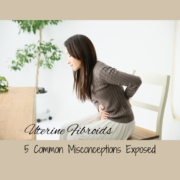THE TRUTH ABOUT UTERINE FIBROIDS
5 Common Misconceptions Exposed
Uterine fibroids are benign growths, developed from muscle tissue, found in and on the uterus. Usually found in women in their 30s and 40s, before menopause, but can occur at any age. Although fibroids are very common, much is left unknown about their cause and people often have misconceptions regarding them. In this blog, we will expose some of these misconceptions and spread some light on uterine fibroids and what you need to know.
1. MISCONCEPTION: FIBROIDS ARE CANCEROUS
Due to the fact that fibroids are found around the uterus, many people assume that they are cancerous and connected to uterine cancer. This is a misconception. Fibroids are not cancerous. Fibroids are benign growths and are not connected to uterine cancer. They are typically not life threatening, but may cause pain or other symptoms.
2. MISCONCEPTION: FIBROIDS CAUSE PAIN AND MUST BE REMOVED
When someone finds out that they have fibroids, they often think the growths MUST be removed. This is not always the case. Some women live with uterine fibroids and do not know it. Some are so small that they are undetectable by the human eye. Because fibroids vary in size, it is common for them to be unsystematic and not cause any pain. Some women do not realize they have them unless they are spotted in a routine exam or ultrasound.
Common symptoms of uterine fibroids include:
- Heavy or prolonged periods
- Bleeding between periods
- Abdominal discomfort and/or fullness
- Pelvic pain
- Lower back pain
- Bladder symptoms, such as frequent urination or difficulty emptying the bladder
- Bowel symptoms, such as constipation or excessive straining with bowel movements
3. MISCONCEPTION: FIBROIDS ARE ONLY FOUND IN AFRICAN AMERICAN WOMEN
Fibroids can be found in women of any age, race, shape and size. However, African American women are more likely to have fibroids than any other racial group. These fibroids are also usually larger and cause more problematic symptoms.
Much is left unknown about uterine fibroids when it comes to causes and risk factors, and keeping a healthy weight, balanced diet and normal blood pressure decreases your risk of developing them. The below are common risk factors associated with Fibroids:
- Race. Although race is not necessarily known to be a factor in the development of uterine fibroids, research has concluded that African American women developed them more than any other race.
- Age. Typically, women of child bearing years are more susceptible to uterine fibroids, however women of an age can develop them.
- Genetics. Fibroids can be hereditary.
- Hormones. High estrogen levels and low progesterone can lead to the development and growth of fibroids.
4. MISCONCEPTION: FIBROIDS CAUSE INFERTILITY
Uterine fibroids are very common and many women with small, unsystematic fibroids can get pregnant naturally. However, certain types of fibroids have been seen in women experiencing infertility issues.
5. MISCONCEPTION: UTERINE FIBROIDS CAN’T BE TREATED
In some cases, uterine fibroids do not need treatment and because some are very small, they may not continue to grow. However, for those that cause pain or are very large, there are several treatment options available for those experiencing uterine fibroid symptoms, some of these include:
- Hysterectomy. Once thought to be the only treatment option for uterine fibroids, there are now more treatments available, but a hysterectomy may be an option.
- Uterine Fibroid Embolization (UFE). UFE is a minimally invasive treatment option where fluoroscopy is used to guide embolic agents to the uterus and fibroids. The agents block arteries and provide blood to the fibroids, causing them to shrink.
- Hormone Treatments. Increased levels of hormones can cause fibroids to grow. Lessening your body’s estrogen and increasing progesterone can help to shrink fibroids.
- Myomectomy. These are non-invasive procedures that remove the fibroids without damaging the uterus. There are several types of the procedure. Some include: Hysteroscopy, Laparoscopy and Laparotomy
- Radiofrequency Ablation (RFA). This procedure uses heat to destroy tissue. This treatment is used for long-term pain management.
Fibroids are typically found during pelvic exams. Further testing may be required to diagnose uterine fibroids. These tests include:
- Ultrasound
- Lab Tests
- Magnetic Resonance Imaging (MRI)
- Hysterosonography
- Hysterosalpingography
- Hysteroscopy
If you experience any symptoms or have a family history of uterine fibroids, speak to your doctor. If your doctor suspects fibroids, they may complete further testing. If you are diagnosed with uterine fibroids, you may have treatment options available.
Sources:
The Mayo Clinic
John Hopkins Medicine
Fibroid Institute Dallas




